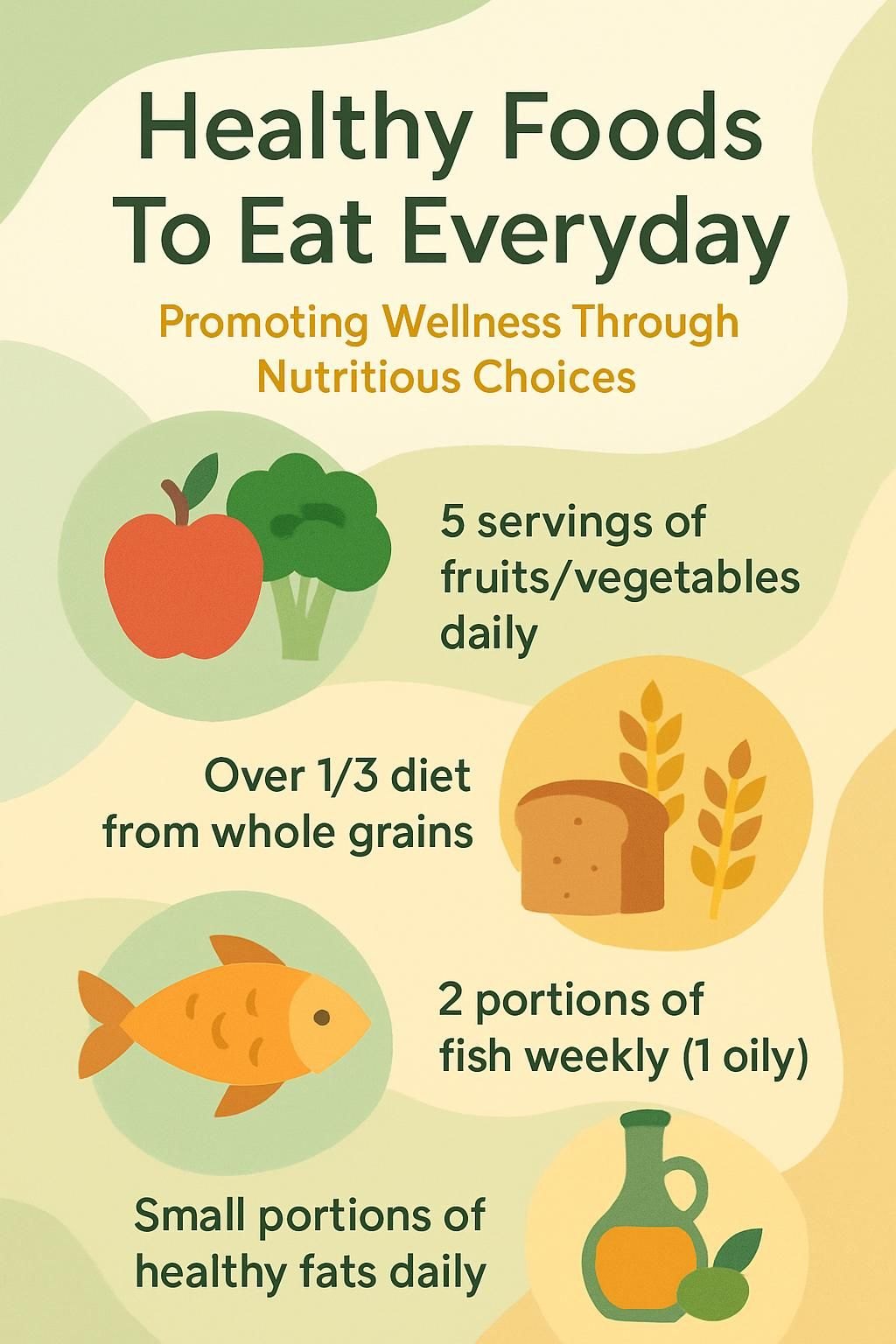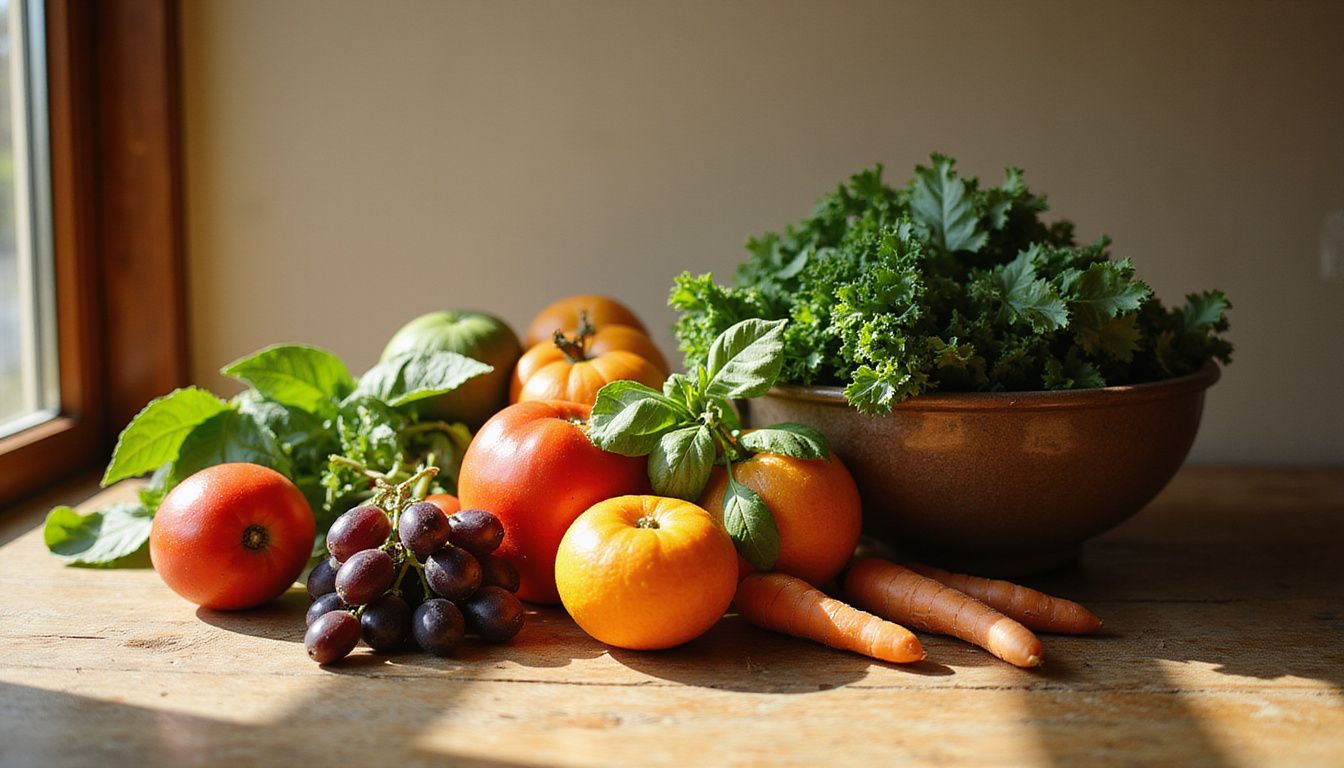Healthy Foods To Eat Everyday: Promoting Wellness Through Nutritious Choices
Our Nutrition Assistant AI Suite will transform your body. You will lose fat, get toned, and build muscle. Gain confidence and optimal health.
You want healthy eating to feel simple, not stressful. The best daily choices are easy to spot once you know what to look for. Healthy Foods To Eat Everyday include fruits, vegetables, whole grains, lean proteins, and healthy fats. These foods supply vitamins, minerals, and dietary fiber your body uses for energy, growth, and a healthy weight.
This guide shares clear steps for building a balanced diet. It draws on tools such as MyPlate and the Eatwell model, along with current research. Use it to plan smart meals, boost energy, and support long-term health.
Key Takeaways
- Aim for at least five servings of fruits and vegetables daily. This habit is linked with lower risk of heart disease, obesity, and some cancers.
- Let whole grains make up just over one third of your plate. Brown rice, quinoa, oats, and whole wheat bread offer fiber and B vitamins for healthy digestion.
- Choose lean proteins such as fish, poultry, eggs, beans, and lentils. Limits on saturated fat can reduce cardiovascular disease risk by about 20 to 30 percent.
- Include healthy fats from olive oil, nuts, seeds, avocados, and fatty fish. They support heart and brain health, but keep portions small due to higher calories.
- Pick low-fat dairy or calcium-fortified alternatives for bones and teeth. Some large studies in 2022 link lower intake of full-fat dairy with reduced cardiovascular mortality.

Why Is Healthy Eating Important?

Healthy eating fuels your day and supports growth, learning, and recovery. It helps you reach and keep a healthy weight, and it lowers risk for chronic conditions such as heart disease and type 2 diabetes.
What are the benefits of a balanced diet?
A balanced diet means eating from all major food groups each day. You get vitamins A, C, and E, B vitamins, minerals like iron and calcium, fiber, and omega-3 fatty acids. These nutrients work together to support your heart, brain, immune system, and digestion.
As children grow past age two, they can follow similar food group proportions as adults for steady development. Matching your energy intake to your daily activity helps prevent unwanted weight gain or loss.
Diverse meals protect health over time. Patterns rich in nutrient-dense foods are linked with lower rates of heart disease and type 2 diabetes. Antioxidants in colorful produce help defend your cells from damage.
Balanced nutrition can help prevent up to one third of cardiovascular diseases,
according to the U.S. Department of Health and Human Services (2020). In my school sports season, swapping sugary snacks for a spinach and egg salad kept my energy steady and helped me focus in class.
How does nutrition promote overall wellness?
Good nutrition supports every organ, from your heart to your skin. Five portions of fruits and vegetables a day can lower risk of several diseases. High fiber foods such as oats, beans, lentils, and whole grains improve digestion and help manage weight.
Lean proteins, including fish, eggs, and poultry, repair tissues and preserve muscle. Choosing foods low in saturated fat supports healthy blood cholesterol. Omega-3 fats in salmon and walnuts support your brain and circulatory system.
Hydration matters too. Drink 6 to 8 glasses of fluids daily. Simple habits such as broccoli soup for lunch or an apple with almond butter as a snack can improve focus through busy days. Following MyPlate helps stabilize mood and supports heart health, as shown in recent USDA reports.
Health information here is educational and does not replace personalized medical advice. Talk with a doctor or a registered dietitian for guidance on your specific needs.
Essential Food Groups to Eat Daily
A variety of foods across each group delivers the full mix of nutrients your body needs. Think of your plate as a team where each player has a job.
Why include fruits and vegetables every day?
Fruits and vegetables provide vitamins, minerals, antioxidants, and fiber. Vitamin C, carotenoids, lutein, zeaxanthin, potassium, and folate show up in apples, carrots, kale, spinach, berries, tomatoes, and cabbage. These nutrients support immunity, vision, and heart health.
Experts recommend at least five portions a day. One portion equals about 80 grams of fresh produce or 30 grams of dried fruit, best at mealtimes. Fresh, frozen, or canned in water or low-salt brine all count.
Build a colorful plate. Swap cookies for fruit, mix dried fruit into oatmeal, add salad at lunch, and double vegetables at dinner. These small moves raise your intake and support a healthy weight.
What are the benefits of whole grains?
Whole grains keep the bran, germ, and endosperm, so you get more fiber and micronutrients than refined grains. Brown rice, quinoa, oatmeal, and whole wheat pasta support stable energy and digestive health.
Current guidelines suggest just over one third of your diet come from starchy foods. Potatoes with the skin add extra fiber. Since carbs have fewer calories per gram than fat, whole grains can help with weight goals.
I traded my morning toast for oatmeal. After two weeks, I felt full longer and my digestion improved. Studies link one serving of whole grains at each main meal with healthier cholesterol over time.
How do lean proteins support health?
Lean proteins build and repair your muscles, bones, and skin. Good sources include beans, lentils, fish, eggs, skinless poultry, and lean cuts of beef or pork. These give you protein with less saturated fat.
Eggs provide protein and key minerals. Two fish meals a week, including one oily fish like salmon, supply omega-3 fats that support heart health. Nuts are nutrient dense, so enjoy small portions. Lean meats such as chicken breast add iron and B vitamins with less fat than many processed meats.
Pair lean proteins with healthy fats and high fiber sides for a strong, balanced meal.
Why choose healthy fats?
Healthy fats support cholesterol balance and heart health. Focus on unsaturated fats from vegetable oils, avocados, nuts, seeds, and seafood. Extra-virgin olive oil provides monounsaturated fats and antioxidant compounds that support your arteries.
Fatty fish such as salmon and mackerel supply omega-3s for brain function and lower inflammation. Macadamias are rich in monounsaturated fat and have less omega-6 than many other nuts. All fats are calorie dense, so keep portions small.
Replacing saturated fat with unsaturated fats can lower heart disease risk by 20 to 30 percent in research studies. Coconut oil is high in saturated fat, though it contains some medium-chain triglycerides. Use it in small amounts.
What Are the Top Healthy Foods to Eat Every Day?
You can build a healthy diet with a short list of everyday staples. These foods are nutrient dense and easy to add to meals and snacks.
How do almonds and other nuts benefit health?
Almonds provide vitamin E, magnesium, antioxidants, and fiber. Reviews in 2021 tied nut intake to better heart markers and lower risk of chronic disease. Nuts deliver healthy fats and plant protein with little saturated fat.
Macadamias are rich in monounsaturated fat. Brazil nuts supply selenium, a mineral that supports the thyroid. Walnuts add omega-3s and pair well with leafy greens such as spinach. Chia seeds offer almost 10 grams of fiber per ounce plus calcium and magnesium. Peanuts are high in plant protein, though peanut butter packs calories, so measure your serving.
A 2023 review by Baer and colleagues linked varied nut intake with steady energy and stable body weight across time.
Why eat apples and berries daily?
Apples and berries offer fiber, vitamin C, and antioxidants that protect your cells. Apples are filling and simple to pack. Blueberries rank high in antioxidant capacity. Strawberries provide vitamin C, fiber, and manganese with few calories.
These fruits fit easily into a balanced diet because they are lower in calories yet rich in nutrients. Oranges add more vitamin C and fiber. Bananas bring potassium and vitamin B6 for steady energy.
Regular fruit intake helps you reach the 5 A Day target. A variety of berries, such as raspberries, deliver fiber and polyphenols that support health [1]. I started adding sliced apples or a handful of blueberries to my lunch. It made healthy snacking simple during busy days.
[1] Slavin JL and Lloyd B, 2012, Advances in Nutrition 3(4), 506-516.
What makes leafy greens like spinach, kale, and broccoli healthy?
Leafy greens are high in nutrients and low in calories. Kale and broccoli provide fiber for digestion and weight control. Both offer vitamins C and K plus antioxidant compounds that help limit cell damage.
Spinach is rich in iron and magnesium while staying light in calories. Broccoli, a cruciferous vegetable, contains more protein than many vegetables. I often toss raw spinach into salads or blend it into smoothies for a quick boost at lunch.
Mixing different greens brings a wider range of phytochemicals to support immunity. Steam or grill broccoli for a flavorful side with little saturated fat.
How do sweet potatoes and root vegetables contribute to nutrition?
Sweet potatoes are loaded with beta carotene, an antioxidant that converts to vitamin A. Potatoes with the skin add potassium, vitamin C, and fiber for heart health and digestion. Carrots bring fiber, vitamin K, and carotenoids.
Turnips and beets add variety and provide slow-release carbohydrates for steady energy. Cauliflower works roasted, in soups, or raw with dips. Root vegetables offer fewer calories per serving than many refined grains, yet deliver many vitamins and minerals.
A mix of sweet potatoes, beets, carrots, and other tubers raises fiber and antioxidant intake. These choices support weight control and everyday energy.
Why include fatty fish like salmon and tuna?
Fatty fish add top quality protein and omega-3 fats that protect your heart and support brain health. Salmon, trout, mackerel, and sardines are excellent choices.
Experts suggest two fish meals weekly, with at least one oily fish serving. Tuna is high in protein and lower in fat and calories, but choose low-mercury, sustainable options when you can. Sardines provide calcium and vitamin D for bones.
Shellfish such as clams and shrimp add zinc with little fat. I began grilling salmon weekly after reading about its heart benefits. Within weeks, my workout endurance improved.
What are the benefits of beans, lentils, and legumes?
Beans, lentils, and other legumes are rich in fiber and plant protein. Chickpeas, black beans, soybeans, kidney beans, and lentils also supply iron, folate, potassium, magnesium, and zinc. Fiber supports regularity and helps you feel full longer, which aids weight management.
Cook kidney beans fully, since raw ones are toxic. Green beans work well in salads or as a steamed side. Lentils have slow-digesting carbs that help steady blood sugar, which can support people with diabetes or afternoon energy dips.
Peanuts, a legume, can lower heart risk when they replace meats high in saturated fat or salty snacks. A 2022 review by Balakrishna and co-authors linked nuts and seeds with lower risk of cardiovascular disease, cancer, diabetes, and death over time. Try soups such as split pea to capture both protein and fiber.
How do whole grains like quinoa, oatmeal, and brown rice help?
Whole grains provide fiber, minerals like magnesium, and plant protein. Quinoa is a complete protein, which means it has all nine essential amino acids. Oatmeal contains beta-glucan fiber that helps lower cholesterol and supports gut health. Brown rice adds fiber and minerals that support energy balance.
Sprouted whole grain breads, such as Ezekiel-style options, add variety. Check labels for salt and added sugars. Whole grains help keep energy steady through the day and support heart health better than refined grains.
Why choose low-fat dairy products?
Low-fat dairy foods such as semi-skimmed milk and low-fat yogurt supply protein and calcium for strong bones and teeth. They offer fewer total calories and less saturated fat than full-fat versions.
Research in 2022 found people who include dairy have lower risk of death from cardiovascular causes than those who avoid it. Full-fat dairy may raise heart risk for some people. If you cannot tolerate milk, choose unsweetened, calcium-fortified alternatives.
One ounce of cheese has about the same protein as a cup of milk. Yogurt with live cultures adds probiotics, which support healthy digestion. I noticed better digestion after adding low-fat Greek yogurt with active cultures to breakfast.
Foods That Are Nutrient Powerhouses
Some foods pack more nutrition into every bite. They help you meet daily goals for fiber, protein, healthy fats, and key vitamins with minimal effort.
Which foods are high in fiber?
Fiber supports digestion, heart health, and fullness between meals. Mix sources to reach your daily target.
- Chia seeds, about 28 grams, provide 9.75 grams of fiber.
- Lentils and kidney beans deliver fiber for gut health and steady energy.
- Potatoes with skin raise fiber, so avoid peeling when possible.
- Oats supply soluble fiber, especially beta-glucans, for a healthy gut.
- Almonds add minerals and fiber, making a smart snack.
- Broccoli and carrots contribute fiber plus antioxidants like lutein and zeaxanthin.
- Whole grains such as brown rice, quinoa, and whole wheat bread boost fiber and nutrients.
- Pulses and legumes support digestion thanks to high fiber and plant protein.
Eating fiber-rich foods helps regulate blood sugar, supports heart health, and keeps you satisfied longer.
What are good protein-packed food options?
Protein builds and repairs tissues. Choose from both animal and plant sources to cover your needs.
- Eggs offer complete protein and minerals such as iron and selenium. One large egg has about 6 grams of protein.
- Lean beef, like sirloin or tenderloin, gives about 22 grams of protein per 3-ounce serving with less fat.
- Chicken breast provides about 26 grams of protein per 3-ounce portion with little saturated fat.
- Fish such as salmon, tuna, and shrimp deliver protein and heart-friendly omega-3s.
- Greek yogurt has 17 to 20 grams of protein per cup and adds calcium.
- Cheese is a concentrated dairy protein and calcium source. Keep portions moderate.
- Quinoa supplies about 8 grams of protein per cooked cup and is a complete plant protein.
- Peanuts and peanut butter add up to 8 grams per 2 tablespoons. They are calorie dense, so measure servings.
- Beans, lentils, and pulses pack both protein and fiber. A half cup of cooked lentils has around 9 grams of protein.
- Oats offer about 5 grams of protein per cooked cup and provide magnesium.
Combine proteins with vegetables and whole grains to create balanced meals that keep you full.
Where can I find healthy omega-3 fatty acids?
Omega-3 fats support heart, brain, and eye health. You can meet your needs with both seafood and plant sources.
- Fatty fish like salmon, trout, sardines, pilchards, and mackerel supply rich omega-3s. One serving a week gives meaningful benefits.
- Walnuts add plant-based ALA, a form of omega-3. Sprinkle on oatmeal or salads.
- Flaxseeds and chia seeds deliver ALA for vegan and vegetarian diets.
- Grass-fed lamb has a better omega-3 to omega-6 ratio than many standard meats.
- Consider an omega-3 supplement if you avoid fish. Ask a clinician for advice.
- Eggs labeled omega-3 enriched are another convenient option.
- Read labels to see how much omega-3 you get per serving.
Rotate these choices each week to keep meals interesting and to meet your goals.
Which foods are rich in vitamins A, C, and E?
Vitamins A, C, and E act as antioxidants and support immunity, skin, and vision. These foods make it easy to cover your targets.
- Sweet potatoes are loaded with beta carotene that converts to vitamin A. One medium potato can exceed the daily value.
- Oranges and strawberries are classic sources of vitamin C. A single serving can provide around 70 milligrams.
- Kale, broccoli, and spinach offer vitamins C and E and minerals like iron and calcium.
- Almonds deliver about 7 milligrams of vitamin E per ounce, close to half the daily value.
- Tomatoes add vitamin C and potassium for heart health.
- Mangoes and carrots are high in beta carotene for vitamin A. One cup of sliced carrots can exceed 300 percent of the daily value.
- Avocados supply vitamins E and C along with healthy fats that support skin.
- Peaches and plums add vitamin C and other antioxidants.
- Bell peppers, especially red, have very high vitamin C levels per cup.
- Reading nutrition labels helps you spot top sources before you buy.
Including these foods supports immune defense and steady energy day to day.
How Can I Build a Healthy Meal Plan?
A good plan keeps you on track when life gets busy. A simple routine also makes a healthy diet easier to follow week after week.
Why is portion control important?
Portion control helps you balance calories and nutrients. Oversized servings, especially of foods high in fat or sugar, lead to overeating and weight gain. Since fats are calorie dense, use small amounts of oil, butter, and spreads.
Daily limits matter. Many adults should keep saturated fat below 20 to 30 grams per day. Cap salt at 6 grams per day. High-salt foods have more than 1.5 grams per 100 grams, so check labels.
Measuring food can help. I used a small scale to serve 80 grams of fruit, 30 grams of dried fruit, and a 150 milliliter glass of juice. It kept my family within smart targets without guessing.
Summary: Right-size portions prevent excess calories, keep sodium and saturated fat in check, and support a steady healthy weight.
How do I incorporate a variety of food groups?
Variety fills nutrient gaps and keeps meals interesting. Aim to include several groups at each meal.
- Choose higher fiber starches such as potatoes with skin, brown rice, whole wheat pasta, or whole grain cereals.
- Stack your plate with fruits and vegetables. Fresh, frozen, canned, dried, and small portions of juice all count toward five a day.
- Rotate proteins. Use fish, eggs, lean poultry, beans, and lentils across the week.
- Add low-fat dairy or calcium-fortified soy drinks for bones and teeth.
- Cook with small amounts of unsaturated oils from olives, canola, nuts, or seeds instead of butter or lard.
Last week I swapped chips for an apple with peanut butter. The change kept me full longer through the afternoon. Small swaps like this support balance across all food groups.
What are tips for meal prepping and planning?
Plan your weekly menu, then prep parts in advance. Pick whole grain options and aim for at least five portions of fruits and vegetables daily.
Batch cook staples on weekends. Roast root vegetables, cook brown rice or quinoa, and grill chicken or tofu. Store them in labeled containers so weekday meals take minutes to assemble.
Use portioned containers to avoid overeating. Add dried fruit to cereal at breakfast. Include salads or cooked vegetables at lunch and dinner. Keep sweets and salty snacks as rare treats.
A quick BMI check can help you track progress. I spend one hour on Sunday washing greens, roasting sweet potatoes, cooking quinoa, and grilling protein. It saves time and reduces the pull of processed food during the week.
What Are the Benefits of Eating Healthy Foods Regularly?
Consistent habits compound over time. Small daily choices can add up to better energy, heart health, and stronger defenses against illness.
How can healthy foods improve energy levels?
Whole grains such as oatmeal and brown rice give slow-release carbs that keep blood sugar steady. Bananas add potassium and vitamin B6, which help convert food to energy.
Lean proteins, including chicken, fish, and eggs, support your muscles so you feel less tired. Include at least one starchy food at main meals to avoid energy crashes.
Hydration matters. Drink 6 to 8 glasses of water daily. Choose apples or oranges over sugary drinks, which often lead to a later slump. Balanced meals with fiber, protein, and healthy fats help prevent the afternoon crash.
What impact do healthy foods have on heart health?
Your daily plate can protect your heart. Limiting saturated fat and salt can improve cholesterol and blood pressure. Fruits, vegetables, whole grains, and pulses add fiber that helps lower LDL cholesterol.
Two servings of oily fish a week contribute omega-3s that protect blood vessels. Swapping red and processed meats for beans or lentils reduces heart risk. Using olive oil and nuts rather than butter adds more unsaturated fats.
A 2022 review found dairy users had lower cardiovascular mortality than non-users [2]. I replaced afternoon chips with a small handful of nuts. After six months, my cholesterol numbers improved.
[2] Global Nutrition Report, 2022.
How do nutritious foods enhance the immune system?
Citrus fruits such as oranges and lemons provide vitamin C to support white blood cell production. Yogurt with live cultures adds probiotics to support gut health, where much of the immune system operates.
Leafy greens supply vitamins A and C, which protect skin and tissue. Almonds and Brazil nuts contribute zinc and selenium for immune function. Carrots and sweet potatoes provide beta carotene that converts to vitamin A. Garlic contains allicin, a compound shown to help lower infection risk.
Eating a wide variety of these foods increases your coverage of immune-supporting nutrients.
How do healthy foods support weight management?
High fiber foods such as whole grains, legumes, fruits, and vegetables keep you full longer. This makes it easier to avoid overeating. Lean proteins preserve muscle during weight loss and increase satiety. Healthy fats from nuts and olive oil help you absorb fat-soluble vitamins.
Many adults take in more calories than they need. Men often need about 2,500 calories per day and women about 2,000. Portion control keeps your intake in range.
Studies show peanut-inclusive diets can support weight loss over time, such as the 2022 review by Petersen and co-authors. I used the NHS free 12-week plan to track meals. It helped me set portions and make better snack choices.
How Can I Make Nutritious Food Choices Every Day?
Labels, smart swaps, and simple hydration habits guide daily decisions. Small steps build confidence fast.
How do I read and understand food labels?
Start with the serving size. Compare it with what you actually eat. Review calories, total fat, saturated fat, and added sugars per serving. High-sugar items have more than 22.5 grams per 100 grams. Low-sugar items have 5 grams or less.
Look for fiber, protein, and calcium. High-salt foods list more than 1.5 grams per 100 grams. For bread and cereals, check both fiber and sugar. Pick dairy alternatives that are unsweetened and calcium-fortified. Use reliable sources such as NHS and FoodData Central if you need to verify figures.
Why should I reduce processed and sugary foods?
Diets high in processed foods and added sugar raise your risk of obesity, heart disease, and tooth decay. They also make weight control harder and can affect blood sugar control.
Choosing more whole foods supports gut health and brain function. Swap packaged snacks for fruit or a small handful of nuts. I cut back on sweet drinks and felt steadier energy through the day.
What are the advantages of choosing seasonal and fresh produce?
Seasonal produce is often higher in vitamins, minerals, and antioxidants because it is picked at peak ripeness. For example, local June strawberries usually carry more vitamin C than off-season imports.
Buying in season also improves flavor and encourages variety, which helps you meet your five a day. Local produce often travels less distance, which may reduce environmental impact. Farmers’ markets can spark ideas and support community growers.
How can I stay hydrated with water and natural juices?
Drink 6 to 8 glasses of fluids daily, with water as your main drink. Keep fruit juice and smoothies to 150 milliliters per day since they are concentrated sources of sugar, even without added sugar.
Hydrating foods help too. Cucumbers, oranges, watermelon, and other high-water foods add fluids plus vitamins and minerals. Following your five a day goal also improves hydration because many fruits and vegetables are water rich.
What Are Common Myths About Healthy Eating?
Food myths spread fast. Knowing the facts helps you choose with confidence and avoid costly detours.
What misconceptions exist about fats and carbohydrates?
Myth: All fats are bad. Fact: You need healthy unsaturated fats from nuts, seeds, fish, and olive or canola oil for heart and brain health. They also help you feel satisfied after meals.
Myth: Carbs always cause weight gain. Fact: Your body relies on carbohydrates for energy. Whole grains provide fiber and nutrients that support blood sugar control. I noticed steadier energy in school when I ate oatmeal for breakfast rather than skipping or choosing sweets.
What is the truth about sugar substitutes?
Sugar substitutes such as aspartame, sucralose, and stevia are approved by the FDA within set limits. Using them in place of table sugar can help you cut calories and reduce the risk of tooth decay.
Experts suggest keeping free sugars below 10 percent of daily calories. I switched from regular sodas to drinks sweetened with stevia. It helped reduce my overall calorie intake while keeping some sweetness in my day. Balance still matters.
Conclusion
Healthy foods make a difference one plate at a time. Build your day around fruits and vegetables, whole grains, lean proteins, and healthy fats. This balanced diet supports a healthy weight, stronger heart, steady energy, and a resilient immune system.
Plan simple meals, read labels, and hydrate well. If you have a medical condition, talk with your clinician or a registered dietitian for personal advice. Start with one small change today and keep going. Your future self will thank you.
Selected sources: U.S. Department of Health and Human Services 2020, USDA MyPlate, NHS guidance, Slavin and Lloyd 2012, Global Nutrition Report 2022, Baer et al. 2021 and 2023, Petersen et al. 2022.
FAQs
1. What are the healthiest foods to eat every day for wellness?
Whole grains, leafy greens, berries, nuts, beans, and fish offer key nutrients that support heart health and lower disease risk. Studies show diets rich in these foods improve cholesterol levels and help maintain a healthy weight [Harvard T.H. Chan School of Public Health].
2. How do nutritious choices promote daily wellness?
Nutritious food provides vitamins, minerals, fiber, and protein needed for energy balance and immune function. For example, eating fruit with breakfast helped me feel more alert during morning meetings.
3. Are there specific foods proven to reduce chronic illness risk?
Yes; research links regular intake of cruciferous vegetables like broccoli or kale with reduced cancer rates [National Institutes of Health]. Whole grains such as brown rice can lower type 2 diabetes risk by up to 30 percent.
4. Can I get enough nutrients from plant-based options alone?
A balanced plant-focused diet supplies most essential nutrients if it includes legumes for protein; seeds for omega-3s; fruits for vitamin C; whole grains for B vitamins; and dark greens for iron and calcium.
Summary: Eating a variety of nutrient-rich foods each day supports long-term health goals while reducing disease risks according to scientific evidence. Choosing whole grains instead of refined ones or adding extra vegetables at lunch makes a measurable difference over time both physically and mentally.







